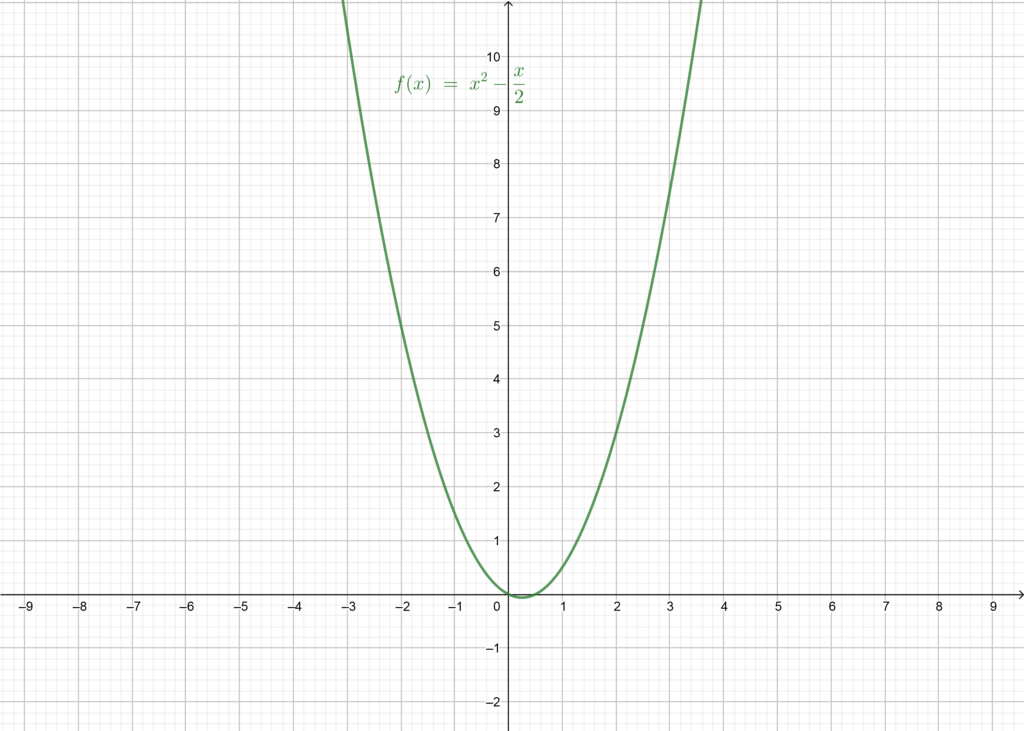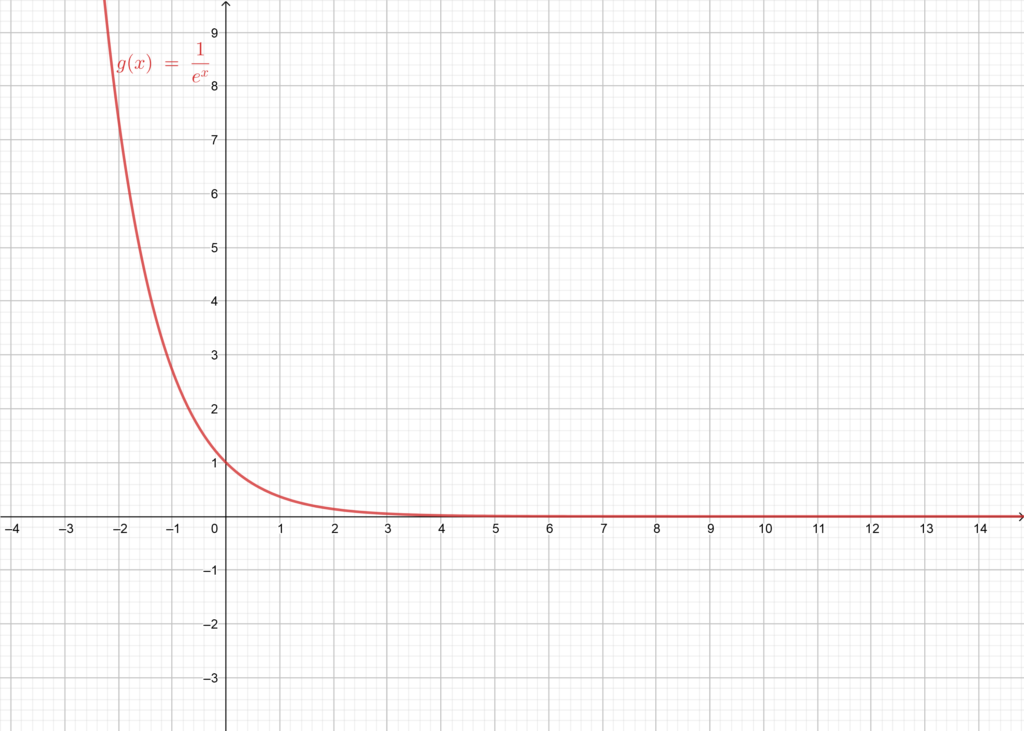In order to study a function and its behavior and properties, an important step is to find out the limits of the function on the ends of its domain of definition. In this article, we will introduce the idea of limits and the different cases that we can come across.
Introduction
We saw in a previous article, an introduction to functions and some of their properties, in this blog post we will learn about function’s limits, where we will try to the behavior of the function near infinity and near specific real values (i.e., the values for who the function isn’t defined), in other terms, we try to determine the function value when approaching the extremities of its domain of definition.
The idea of limits:
To better introduce the idea of limits, let’s take a look at some examples:
Example 1: Let’s the function be defined as follow:
The domain of the function is
.
Let’s evaluate the function when the values of
go bigger and bigger
|
|
1 |
5 |
10 |
|
|
|
|
0.5 |
22.5 |
95 |
9950 |
999500 |
We notice that, as the value of increase, the value of the
increases as well, so we can predict that as the value of
become bigger and bigger, the value of the function
goes bigger and bigger too, meaning that as
approaches infinity (infinitely big) the value of
approaches
as well. In this case, we can use the notation:
And we read the limit of the function as
approaches
, is
.
Here is the graph of the function for a better illustration:
Example 2:
We have the function defined as:
The domain of the function is:
.
Let’s evaluate the function as
takes bigger and bigger values:
|
|
1 |
5 |
10 |
|
|
|
|
0.36787944117 |
0.00673794699 |
0.00004539992 |
3.720076e-44 |
(To close to zero that the calculator shows exactly 0) |
We can easily notice that as increases in value the value of
goes closer and closer to 0, so we can predict that as
approaches infinity the value of the function
approaches 0, and we note:
So, From the two previous examples, we conclude that a limit of a function can a real number or .
Here is the graph representing the function , where we can see the graph approaching the X-axis
as
goes towards infinity.
Example 3:
Let’s consider the function defined as follow:
We have the domain of the function is
.
We know that the function h isn’t defined for (because we can’t divide by 0), but let’s try and see the values of
as
approaches 0 with both greater and less than 0, meaning we evaluate
when
approaches 0 from the right side (i.e.,
), and when
approaches 0 from the left side (i.e.,
).
Let’s start with evaluating as
gets closer and closer to zero with greater values:
|
|
1 |
0.5 |
0.1 |
0.01 |
0.001 |
0.0001 |
0.00001 |
|
|
1 |
2 |
10 |
100 |
1000 |
10000 |
100000 |
We can clearly notice that as gets closer and closer to zero with greater values, the values of the function
become bigger and bigger, we can predict then that it keeps increasing in value towards
, in other terms as
approaches 0 with greater values,
tend to
, and we note:
And we read: the limit of the function as
approaches 0 with greater values (or as
approaches 0 from the right side) is
.
Now let’s evaluate as
approaches 0 with values less than zero:
|
|
-1 |
-0.5 |
-0.1 |
-0.01 |
-0.001 |
-0.0001 |
-0.00001 |
|
|
-1 |
-2 |
-10 |
-100 |
-1000 |
-10000 |
-100000 |
This time, notice that the value of the function gets smaller and smaller, as
gets closer and closer to 0 with smaller values i.e., from the left side, so this way we can predict that
will keep decreasing towards
, meaning that as
approaches 0 with smaller values,
tends to
, and we note:
Here is the graph of the function , notice that the graph goes up to
if we get closer to 0 from the right side, and it goes down to
if we get closer to 0 from the left side.
Let’s summarize what we learned:
Finding the limit of a function is to determine its value tendency when approaches infinity or a real number (usually a value at the extreme of the function’s domain for which the function is not defined).
We evaluate limits for when approaches the ends on the domain of definition of a function, otherwise, if we want to evaluate the function for a value of
inside the domain, we just calculate
, but for the values at the extremes of the domain, whether they are a real number or infinity, we cannot calculate them and that why we try to find the limits.
For example, we cannot just evaluate because infinity is not a number, infinity is an idea, a concept, so instead, we calculate the limit of the function
when
goes to infinity.
Same thing for a value of on the extreme of the domain and for which the function isn’t defined, for example, a function
defined on a domain
, we know that
doesn’t belong in the domain of
so we cannot evaluate
, instead, we calculate the limit of the function
when
approaches the value of
. In this case, we have two limits to determine, one for when
approaches
with greater value (i.e.,
where
is very small) or in other terms from the right side; and the second for when
approaches
with smaller values (i.e.,
where
is very small) or in other terms from the left side.
Finite and infinite limit when approaching infinity:
Finite limit
Definition 1: Finite limit on or
:
Suppose a function defined on the domain
and
a real number.
To say that the limit of on
is
is to say that every open domain containing
contains all the values of
for
big enough. We write
And we read tends to
when
tends to
.
Explanation:
To say that the limit of as
tends to
is
, means that
becomes very close to
and therefore the value
lies in the interval
, with
a small real number, or in other terms
.
Remarque: we get a similar definition and result for (i.e., for
defined on
and
tends to
).
Examples:
Infinite limit
Definition 1: Infinite limit on or
:
Suppose a function defined on the domain
and
a real number.
To say that the limit of when
tends to
is
, means that for a real number
with
, every interval
contains all the values of
for
big enough. We write
And we read tends to
when
tends to
.
Definition 2:
Suppose a function defined on the domain
and
a real number.
To say that the limit of when
tends to
is
, means that for a real number
with
, every interval
contains all the values of
for
big enough. We write
And we read tends to
when
tends to
.
Remarque: we get two similar definitions and result for (i.e., for
defined on
and
tends to
).
Examples:
Finite and infinite limit when approaching a real value:
Finite limit when approaching a real value:
Definition:
Suppose a function defined on the domain
and
a real number.
To say that the limit of when
tends to
is equal to
, means that every open interval containing
contains all the values of
for
big enough. We write
And we read: tends to
when
tends to
.
We distinguish two cases, the first is when tends to
with greater values (or in other terms from the right side) and we note:
And the second case, when tends to
with smaller values (or in other terms from the left side) and we note:
Let’s take a look at an example for better understanding:
We have the function defined on
as follow:
If we take a look at the graph of the function , we notice that as
approaches 0 the value
approaches 1, and if we zoom the graph or if we use a table to calculate values as
approaches 0 then we can see that we can get
as close to 1 as we want if we get
close enough to 0. Therefore, we have:
Infinite limit when approaching a real value:
Definition: Suppose a function defined on the domain
.
To say that the limit of when
tends to
is
, means that for a real number
with
, every interval
contains all the values of
for
big enough. We write
And we read: tends to
when
tends to
.
We distinguish two cases, the first is when tends to
with greater values (or in other terms from the right side) and we note:
And the second case, when tends to
with smaller values (or in other terms from the left side) and we note:
Here is an example for better understanding:
The function is defined on the interval
as follow:
If we take a look at the graph we can clearly notice that as
approaches 0 with greater value i.e., from the right side, the value of
tends to
, so we write:
Also, we can see that as approaches 0 with smaller values i.e., from the left side, the value of
tends to
, so we write:
Now why don’t you try it yourself, in the following graph of the function , you can slide the two points
and
on the X-axis, and approach 0 as close as you want while noticing the value of
goes to infinity with different signs
Conclusion:
We learned in this article the idea of limits and how it helps us understand the behavior of a function near the edges of its domain of definition. this is just an introduction we still have much more to learn and
Surely you want more fun with limits, so check out this random rational functions generator, as its name suggests it randomly generate a rational function (a quotient of two polynomial functions) and draws its graph. Take a look and enjoy graphicly seeing the different limits of these functions on their domains. Have Fun!!!!!
You want to learn more fun subjects, check the post about Functions and some of their properties, or the one about How to solve polynomial equations of first, second, and third degrees!!!!!
And don’t forget to join us on our Facebook page for any new articles and a lot more!!!!!


![Rendered by QuickLaTeX.com \[g(x)=\dfrac{1}{e^{x}}\]](https://www.mathacademytutoring.com/wp-content/ql-cache/quicklatex.com-7873aad44228443f064c7bb61849bc3d_l3.png)

![Rendered by QuickLaTeX.com \[h(x)=\dfrac{1}{x}\]](https://www.mathacademytutoring.com/wp-content/ql-cache/quicklatex.com-137da92570d1c9d133464c2fff8555d8_l3.png)

![Rendered by QuickLaTeX.com \[\lim_{x\rightarrow+\infty}\dfrac{1}{\sqrt{x}}=0 \;\;\;\;\; \lim_{x\rightarrow+\infty}\dfrac{1}{e^{x}}=0 \;\;\;\;\; \lim_{x\rightarrow+\infty}\left( \dfrac{1}{x}+3 \right)=3\]](https://www.mathacademytutoring.com/wp-content/ql-cache/quicklatex.com-695eeba503ca5d4879e0161c18883423_l3.png)
![Rendered by QuickLaTeX.com \[f(x)=\dfrac{\sin(x)}{x}\]](https://www.mathacademytutoring.com/wp-content/ql-cache/quicklatex.com-29df373076655be9c6460d71e8382fc0_l3.png)
![Rendered by QuickLaTeX.com \[\lim_{x\rightarrow0}\dfrac{\sin(x)}{x}=1\]](https://www.mathacademytutoring.com/wp-content/ql-cache/quicklatex.com-8d63a4d92434e9389a03fa96ebe5c918_l3.png)
![Rendered by QuickLaTeX.com \[g(x)=\dfrac{1}{x}\]](https://www.mathacademytutoring.com/wp-content/ql-cache/quicklatex.com-c7fba88578d7dcab74791b75798568d0_l3.png)
![Rendered by QuickLaTeX.com \[\lim_{x\rightarrow 0^{+}}\dfrac{1}{x}=+\infty\]](https://www.mathacademytutoring.com/wp-content/ql-cache/quicklatex.com-9ab42db9a55b5698c0ccd6f74dec135f_l3.png)
![Rendered by QuickLaTeX.com \[\lim_{x\rightarrow 0^{-}}\dfrac{1}{x}=-\infty\]](https://www.mathacademytutoring.com/wp-content/ql-cache/quicklatex.com-0f4b2058d89cc5b0a3aa427a4695e297_l3.png)